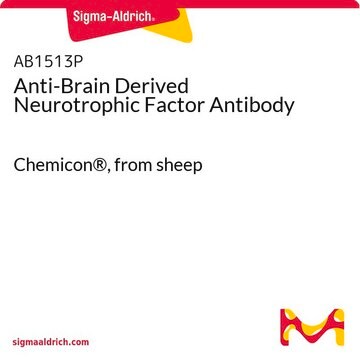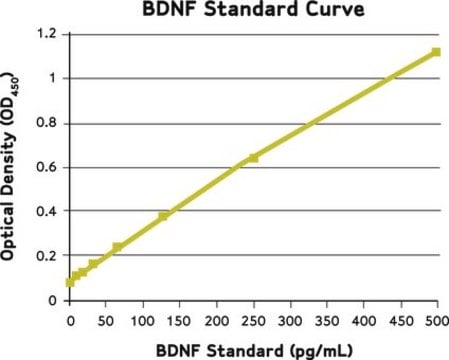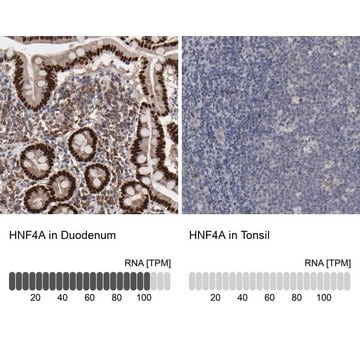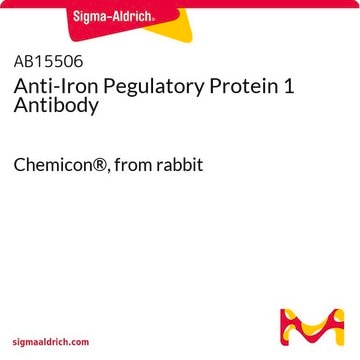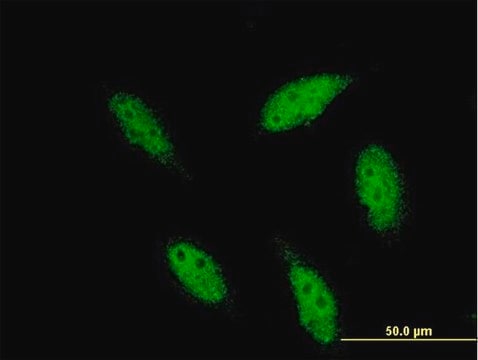AB1513
Anti-Brain Derived Neurotrophic Factor Antibody
serum, Chemicon®
Synonym(s):
BDNF
Sign Into View Organizational & Contract Pricing
All Photos(1)
About This Item
UNSPSC Code:
12352203
eCl@ss:
32160702
NACRES:
NA.41
Recommended Products
biological source
sheep
Quality Level
antibody form
serum
antibody product type
primary antibodies
clone
polyclonal
species reactivity
human, rat
manufacturer/tradename
Chemicon®
technique(s)
ELISA: suitable
immunohistochemistry: suitable
western blot: suitable
NCBI accession no.
UniProt accession no.
shipped in
wet ice
target post-translational modification
unmodified
Gene Information
human ... BDNF(627)
Specificity
Brain Derived Neurotrophic Factor (BDNF). Neutralizes BDNF, but not other neurotrophins. By one site ELISA, less than 1% cross-reactivity against mouse NGF, recombinant human NT3 or neurotrophin 4.
The antibody was tested on human and rat derived samples, but based on sequence similarity it is expected to react with mouse and other mammalian species. The peptide sequences of human, rat and mouse BDNF are identical.
The antibody was tested on human and rat derived samples, but based on sequence similarity it is expected to react with mouse and other mammalian species. The peptide sequences of human, rat and mouse BDNF are identical.
Immunogen
Recombinant Human Brain Derived Neurotrophic Factor (BDNF).
Application
Anti-Brain Derived Neurotrophic Factor Antibody is an antibody against Brain Derived Neurotrophic Factor for use in ELISA, WB, IH.
Immunohistochemistry: 1:200-1:2,000 (see suggested protocol).
Immunoblotting: 1:200-1:2,000 we recommend preparing the BDNF samples for western blot by the method of Semba-Katoh, R et.al (J. Neurochemistry 69(1):34-42, 1997) because BDNF is not easily extracted in standard buffers. Dissected tissues should be homogenized in 10 volumes of 100mM phosphate buffer containing 1mM EDTA, 2M guanidine hydrochloride (pH 7.2), and three protease inhibitors, 10mM N-ethylmaleimide, 0.36mM pepstatin, and 1mM PMSF. Homogenates are then sonicated and centrifuged at 46K x g for 30 minutes at 4°C.
ELISA: 1:200-1:2,000
Inhibition of biological activity in vitro: 1:10-1:50
Use neat for in vivo animal studies.
Optimal working dilutions must be determined by end user.
Immunoblotting: 1:200-1:2,000 we recommend preparing the BDNF samples for western blot by the method of Semba-Katoh, R et.al (J. Neurochemistry 69(1):34-42, 1997) because BDNF is not easily extracted in standard buffers. Dissected tissues should be homogenized in 10 volumes of 100mM phosphate buffer containing 1mM EDTA, 2M guanidine hydrochloride (pH 7.2), and three protease inhibitors, 10mM N-ethylmaleimide, 0.36mM pepstatin, and 1mM PMSF. Homogenates are then sonicated and centrifuged at 46K x g for 30 minutes at 4°C.
ELISA: 1:200-1:2,000
Inhibition of biological activity in vitro: 1:10-1:50
Use neat for in vivo animal studies.
Optimal working dilutions must be determined by end user.
Research Category
Neuroscience
Neuroscience
Research Sub Category
Neurochemistry & Neurotrophins
Neuroinflammation & Pain
Neurochemistry & Neurotrophins
Neuroinflammation & Pain
Physical form
Sheep serum. Lyophilized, no preservatives. Reconstitute with 100 μL of sterile distilled water. Centrifuge to remove any insoluble material.
Storage and Stability
Maintain lyophilized material at -20 to -70°C for up to 12 months after date of receipt. After reconstitution maintain at -20 to -70°C in undiluted aliquots for up to 6 months. Avoid repeated freeze/thaw cycles. Glycerol (ACS grade or better) can be added (1:1) for additional stability.
Legal Information
CHEMICON is a registered trademark of Merck KGaA, Darmstadt, Germany
Disclaimer
Unless otherwise stated in our catalog or other company documentation accompanying the product(s), our products are intended for research use only and are not to be used for any other purpose, which includes but is not limited to, unauthorized commercial uses, in vitro diagnostic uses, ex vivo or in vivo therapeutic uses or any type of consumption or application to humans or animals.
Not finding the right product?
Try our Product Selector Tool.
recommended
Product No.
Description
Pricing
Storage Class Code
10 - Combustible liquids
Certificates of Analysis (COA)
Search for Certificates of Analysis (COA) by entering the products Lot/Batch Number. Lot and Batch Numbers can be found on a product’s label following the words ‘Lot’ or ‘Batch’.
Already Own This Product?
Find documentation for the products that you have recently purchased in the Document Library.
Mallappa K Kolar et al.
Scientific reports, 7(1), 12605-12605 (2017-10-05)
The current gold standard treatment for peripheral nerve injury is nerve grafting but this has disadvantages such as donor site morbidity. New techniques focus on replacing these grafts with nerve conduits enhanced with growth factors and/or various cell types such
Shao-Han Chang et al.
Behavioural neurology, 2021, 6657716-6657716 (2021-03-26)
Whether BDNF protein and BDNF mRNA expression of the medial prefrontal cortex (mPFC; cingulated cortex area 1 (Cg1), prelimbic cortex (PrL), and infralimbic cortex (IL)), amygdala, and hippocampus (CA1, CA2, CA3, and dentate gyrus (DG)) was involved in fear of
Afonso Kopczynski et al.
Experimental neurology, 363, 114352-114352 (2023-02-23)
Decreasing neurotrophic support and impaired mitochondrial bioenergetics are key mechanisms for long-term neurodegeneration and cognitive decline after traumatic brain injury (TBI). We hypothesize that preconditioning with lower and higher volumes of physical exercise upregulates the CREB-BDNF axis and bioenergetic capability
Christopher R Hansebout et al.
Neural regeneration research, 7(28), 2165-2175 (2012-10-05)
Previous studies have shown that transplanted enteric glia enhance axonal regeneration, reduce tissue damage, and promote functional recovery following spinal cord injury. However, the mechanisms by which enteric glia mediate these beneficial effects are unknown. Neurotrophic factors can promote neuronal
Kosuke Fujita et al.
Molecular therapy. Methods & clinical development, 5, 130-141 (2017-05-10)
Retinal ganglion cell degeneration triggered by axonal injury is believed to underlie many ocular diseases, including glaucoma and optic neuritis. In these diseases, retinal ganglion cells are affected unevenly, both spatially and temporally, such that healthy and unhealthy cells coexist
Our team of scientists has experience in all areas of research including Life Science, Material Science, Chemical Synthesis, Chromatography, Analytical and many others.
Contact Technical Service